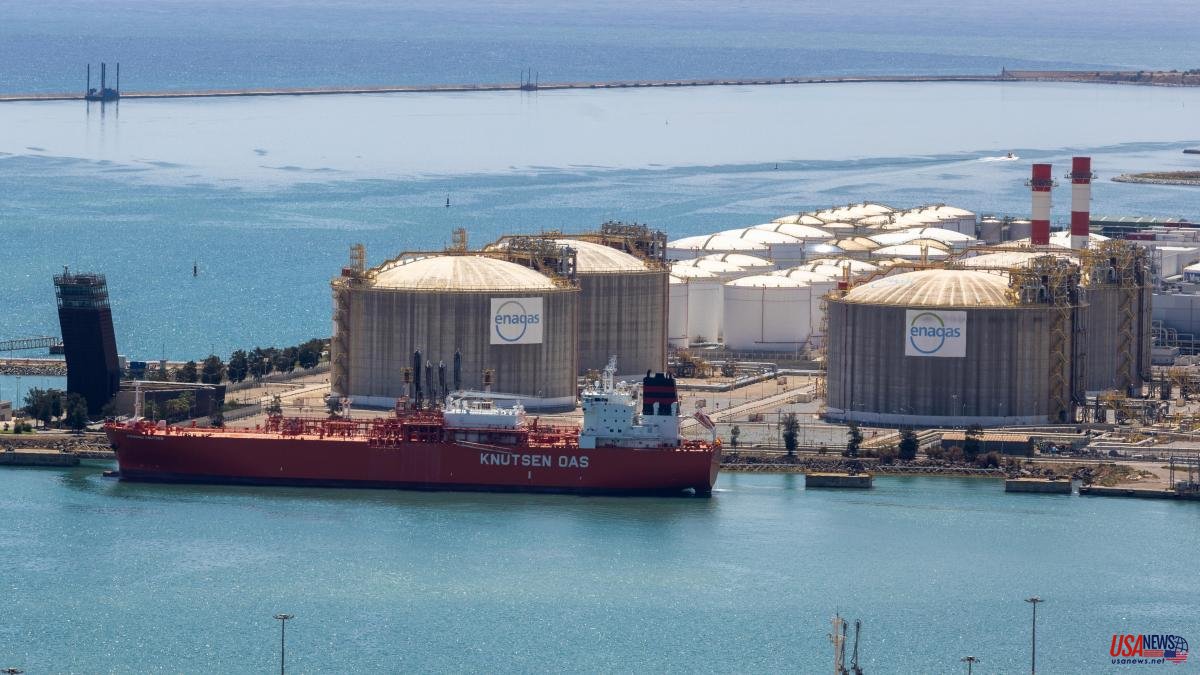The Midcat, a gas pipeline that hopes to connect the Iberian Peninsula with France and Europe through Catalonia, ends today in Hostalric. The invasion of the Ukraine and skyrocketing prices on the energy front may blow it up to Berlin. Germany presses for the infrastructure, in the drawer since 2019, to revive. Spain and Portugal bless the push. But it is not easy. Who pays it, the deadlines, the opposition of the citizens or the technical difficulties stand as great obstacles to opt for being a salvation in the current energy crisis. Thus, the view is set on the long term, with the objective of transporting hydrogen, as Brussels collects in its REPowerEU plan to cut dependence on Russia. And there are also buts...
The first key point is in the money. The magnifying glass must be put on the section called STEP, the connection with France of the Midcat. On the Spanish side it is about 106 kilometers. It would cost 370 million euros, according to Enagás calculations. They are divided into 225 million for the tube itself and 145 million for a compression station for renewable hydrogen, with which it would be ready to transport this alternative, it is assured. In France, you have to connect from the border to Barbaira –near Carcassonne–. It's about 120 kilometers. Then it also has to complete and reinforce the union with the rest of Europe throughout the Gallic territory. According to calculations by the Ministère de la Transition Énergétique, to do this the bill shoots up to 3,000 million.
In Paris, excessive spending is seen and the Spanish spirit is slowed down: according to Minister Teresa Ribera, the Spanish part could be ready in eight or nine months. In France there is talk of "many years" to be operational. It goes at different rates. “In Spain the section is processed. The affected properties have even received compensation. The fastest phase remains, the execution. In France, the procedure has not even been carried out”, explains Josep Maria Montagut, president of the energy commission of the Col legi d'Enginyers Industrials de Catalunya. In fact, Enagás has already acquired material for the work.
Today it seems that if the border is reached, the gas will end up nowhere. The reason, the French political barrier. The Midcat is called into question because there are already existing connections (Larrau and Irun), because of the cost, the deadline – "it would not solve the current crisis", it is said, without reaching winter – and because it does not fit into its nuclear-based model nor in the transition towards neutral emissions. Also because she herself wants to be a relevant player in the sale of gas, so she would not be so interested in a network from the south to open up ground to competitors, it was pointed out in the French press these days.
The unlocking may be in Brussels and its REPowerEU plan, of 210,000 million. In it, the Midcat is identified as a necessary infrastructure, especially as a hydrogen corridor, apart from a gas union from Barcelona to Livorno (Italy). "It has to be done with European funds, with a continental vision," point out market sources. The European manna would reduce French reticence, although much precision and final approval are lacking. Paris is willing to dialogue if the factors against it are valued. “At the moment there is no time horizon on the table for the operation in its entirety. We have to wait for France to make an official statement”, they explain at the Ministry for the Ecological Transition.
To exert pressure, Spain has found a powerful ally in Germany, whose model based on cheap Russian gas is floundering. Now they need gas for their homes and industry almost desperately. If it goes ahead, another unknown: how relevant will the Midcat be? The forecast is that it will move 7.5 bcm (billion cubic meters of gas) per year in both directions, double the current interconnection. Gas consumption in the EU was 412 bcm in 2021, according to the European Commission, of which only 50.6 were produced at its borders. 137 bcm (31%) arrived from Russia, with 58 from Nord Stream 1, the main artery.
The Midcat, thus, is dwarfed between such magnitudes. “She will have the capacity to alleviate the Russian contribution. It is an important piece, but one more piece”, explains Mariano Marzo, professor emeritus at the UB. It will undoubtedly serve to value the seven Spanish regasification plants and their Portuguese counterpart, to which liquefied gas (LNG) from Africa, the US or the Middle East can reach, with good capacity. “The Iberian Peninsula has 30%-35% of the regasification power of the EU. Interested in taking advantage of the facilities, selling the surplus. Spain needs to export and Germany wants the gas, but France does not and its position is quiet”, summarizes Antonio Aceituno, CEO of the consulting firm Tempos Energía.
It will not be salvation, but it will be a good alternative. The danger is that it takes so long that it loses meaning. Germany is already maneuvering with floating LNG terminals and France sees them as the way out of the current crisis. "We have to see if Midcat still seems profitable when they are operational," warns Aceituno. Pipeline gas should be cheaper than ships if it already arrives processed, he believes. "Interconnections will make us Europeans stronger," concludes Montagut.
Another unknown is the public response, with opposition at the local level and from environmental associations on both sides, with notoriety in France. With the project in the dry dock they had withdrawn from the spotlight, but groups like the Platform Respond to Midcat are already reviving, with more than a decade behind them. The tube is buried, so it does not represent a visual shock like that of windmills or solar panels, but it entails perpetuating a model "that would tie the continuity of the gas sector, with a high environmental impact", denounces Javier Andaluz, responsible of climate and energy of Ecologists in Action.
And here the trump card of green hydrogen is a long-term card. It still needs a route... “The substantive thing is that the tube can also transport green hydrogen. That gas is a measure in the short term, but that work be done from the beginning with a medium and long horizon of hydrogen ready ”, they point out in the Government. “Hydrogen is not here yet. It is a project, a child who has clear problems. The electrolysers go with electricity and the prices now do not accompany. The water is also treated. It catches us at a bad time, there is a lack of more technology and less ideology, ”says Marzo. And prepared infrastructures, which make the work more expensive. “Hydrogen is very volatile. It must go to high pressures, with metal tubes that do not corrode. With technologies that are not even developed. Today it is more of a chimera”, Andaluz completes. France does not see clearly neither the supply nor the demand for many years.
Everyone has shown their cards. Now it's diplomacy. “Germany has shown its interest because it is fast, and also Brussels. The Midcat will be on everyone's table when they return from the holidays”, points out from the Ribera ministry.













